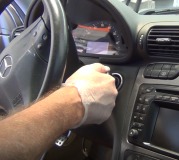After changing the oil pan, I did not properly mount the starter to the trans bell-housing correctly (bottom end was not flush to bell-housing, about four to five mm) and then I over-torqued the E12 bolts where one broke off the bottom flange from the starter. Removal and/or loosening up of the transmission from the block is requited to reach two ten cm, ten mm bolts). The constraints is this area are very tight, needless to say. Hard to reach and do it right.
The original starter was operable and never had issues. After I finished with the above work on the the car and attempted to start it, there were loud, grinding noise. It was not pretty. It was obviously not aligned with the flywheel.
Second time I tried to start it after I re-positioned the starter. I used some washers and tried to get the second flange snug on the bell-housing, even though it mostly sheared off. In any case, the solenoid would activate one hundred percent of the time from when battery was re-attached. This would occur whether the key was in the OFF, ON or ACCY position. It was similar to a high whine. I checked to make sure that the four wires were properly connected on the starter and not on the wrong posts. I considered the shaft, pinion or some other internal component or components, toasted.
Third attempt to start after changing the starter (I had a second, used starter on-hand): After making sure it was properly mounted, it would just click, there was no Bendix action (I am assuming). On this starter, the dowel hole was sheared off at the top where the dowel pin inserts- but it appeared to fit properly nonetheless. Both E12 torx were okay.
Fourth attempt (third starter): I purchased a new starter (Bosch) and installed it. The starter exhibited the same behavior as the used one, which would simply click, but would not spin, same as it was doing on the second, third attempt. This is where I am now.
I do have full dash lights, but I checked the battery anyway and it was only +12.08v after sitting for a few weeks. I used a trickle charger from last night and got it to +12.79 volts. Should I remove the battery and get a full charge at an Autozone or test with another battery from another E36 (I have several)?
I was not able to rotate the crank with key in the ignition, with the selector in neutral. Aside from feeling that the trans flywheel is jammed, I am wondering about the EWS, relays and/or fuses and at this rate. I think the starter solenoid is controlled by the DME. I was referring to an electronic troubleshooting guide for this year/make/model: http://wedophones.com/Manuals/BMW/1997 BMW 318is-c - 328i-c Electrical Troubleshooting Manual.pdf.
The first time I re-attached the battery cables to the terminals, I used the positive lead first, rather than the negative first. There were a lot of sparks at that point wondering if I blew something, like the fusible bridge. since at that time it appeared that the start shaft did not even spin, with the unit only clicking.
I am not a mechanic but a BMW enthusiast. Just want to know where I can begin doing troubleshooting. I do have a multi-meter but unsure of how to use it, aside from checking voltage and resistance.
SPONSORED LINKS
Saturday, July 1st, 2017 AT 5:10 PM




